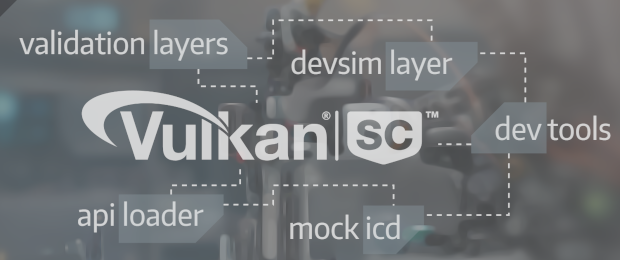Vulkan SC enables safety-critical system implementers to leverage graphics and compute acceleration through a powerful explicit and deterministic API built based on the open industry standard Vulkan API from the Khronos Group. This comes with the same level of flexibility and direct access to the underlying hardware that Vulkan developers are familiar with, including fine-grained control over resource management, synchronization, and execution scheduling.
Vulkan SC 1.0 is derived from Vulkan 1.2 through the removal of runtime functionality that is not relevant in safety-critical markets, and updated design to provide predictable execution times and result.
RasterGrid is proud to play a key role in the evolution of Vulkan SC since 2023. As the maintainer of the Vulkan SC SDK and its components, we had the opportunity to port multiple Vulkan developer tools to be usable with Vulkan SC, as well as designing and implementing entirely new components and tools specifically for Vulkan SC.
Articles & Resources
- The Vulkan SC Emulation driver stack – Our blog post about the Vulkan SC Emulation implementation on top of Vulkan
- Behind the scenes: the Vulkan SC Ecosystem – Our blog post about the adventure of porting Vulkan developer tools for Vulkan SC
- Vulkan SC: Overview – and how it is different from the Vulkan you already know – Khronos Blog post providing an overview of Vulkan SC
- Vulkan SC Khronos Home Page – Features additional information about Vulkan SC and links to useful resources
Vulkan SC SDK Components
The Vulkan SC SDK features several components, including ported versions of key Vulkan developer tools comprising the common Vulkan SC toolset, along with tools specifically designed for Vulkan SC.
Common Vulkan SC Components
- Vulkan SC Headers – Official API headers
(including combined header generation tooling) - Vulkan SC Utility Libraries – Utilities used by other components
- Vulkan SC Loader – ICD loader
- Vulkan SC Tools – Collection of miscellaneous tools
vulkanscinfo,vksccubedemo, Mock ICD, Device Simulation Layer - Vulkan SC Validation Layers – Validation layers
(including synchronization validation)

Vulkan SC Emulation Driver Stack
The Vulkan SC Emulation driver is a major milestone in the development of the Vulkan SC SDK, enabling developers to build Vulkan SC applications on any Windows or Linux machine having a Vulkan capable GPU. This eliminates the need for developers to have access to specialized hardware and software components that are typically required to target safety-critical systems. Furthermore, the emulation driver stack also comes with display emulation, therefore even applications that need to target multiple displays can be developed on simple consumer hardware.

- Vulkan SC Emulation ICD
ICD emulating the Vulkan SC API on top of Vulkan
- Vulkan SC Emulation PCC
Pipeline Cache Compiler to use with the Emulation ICD



